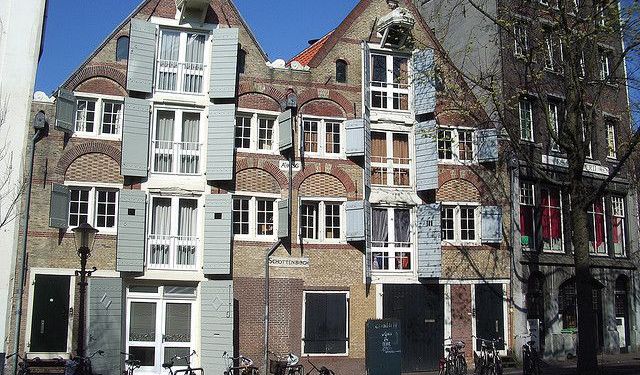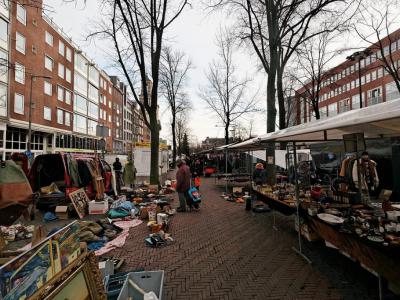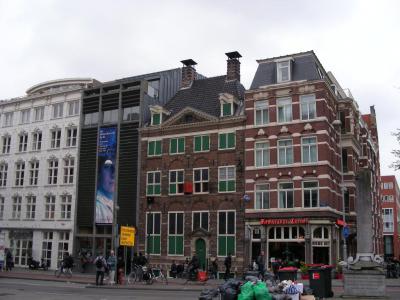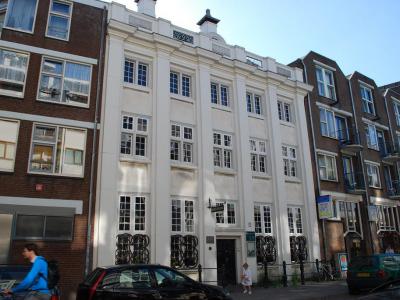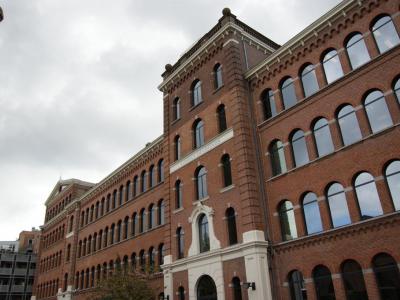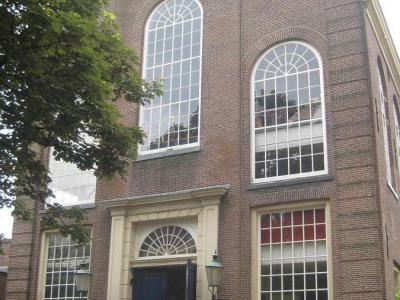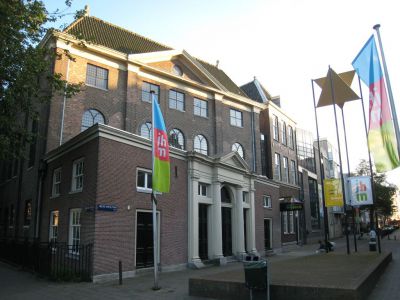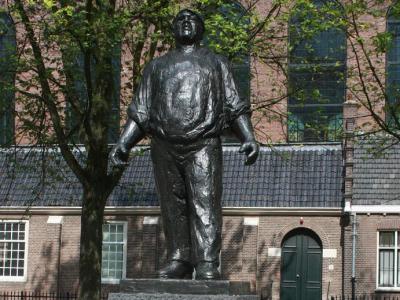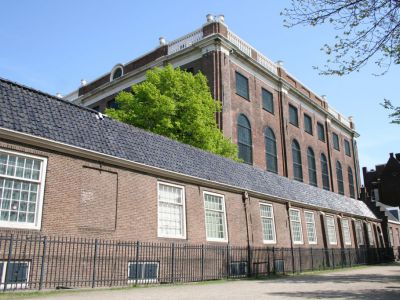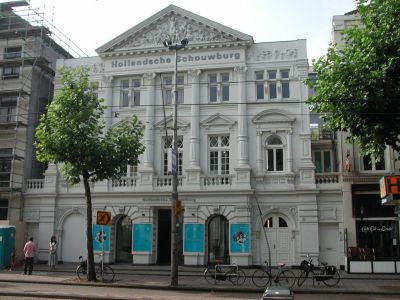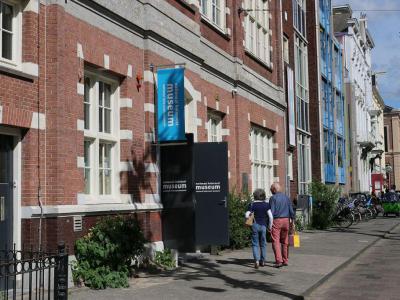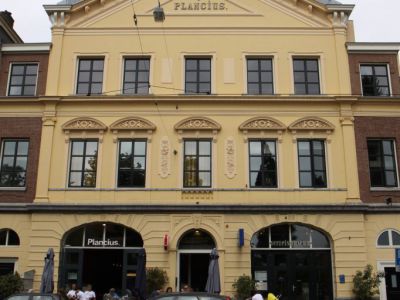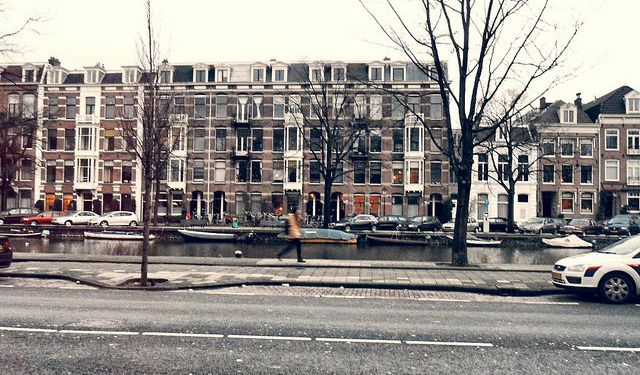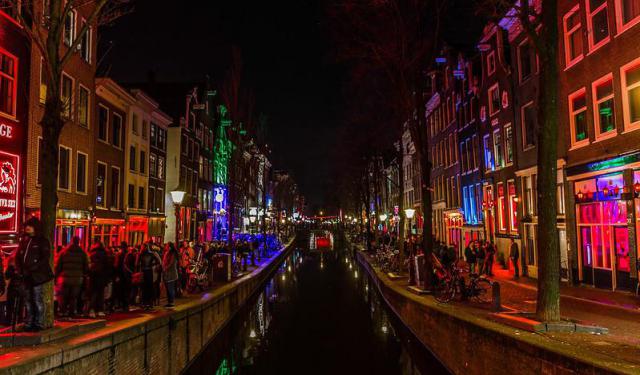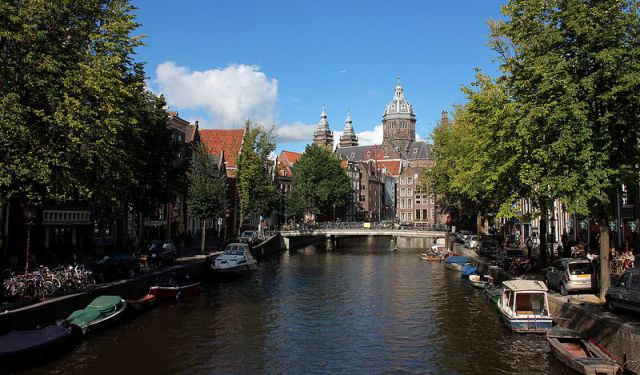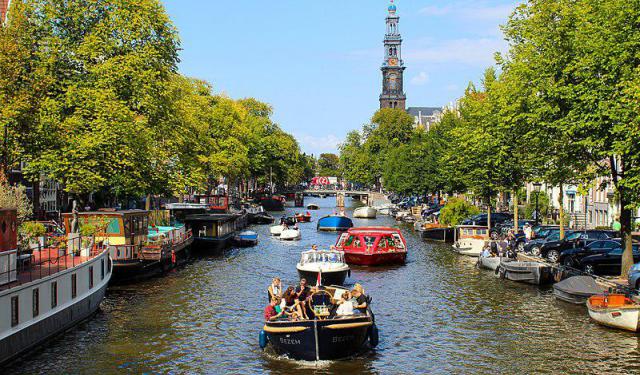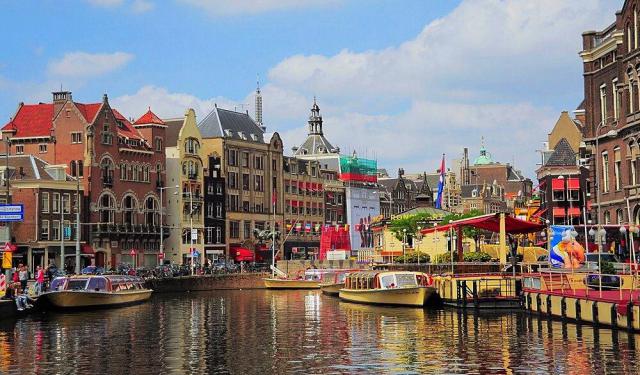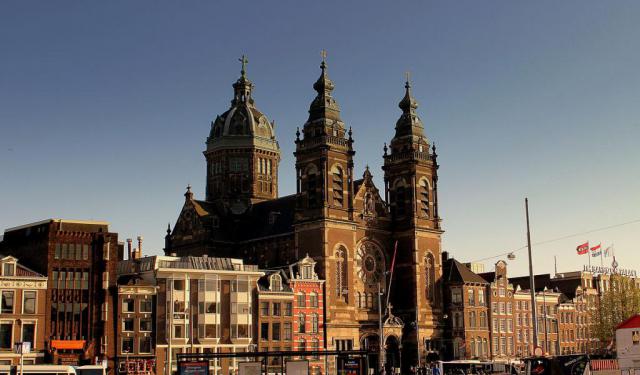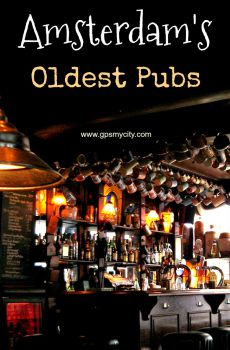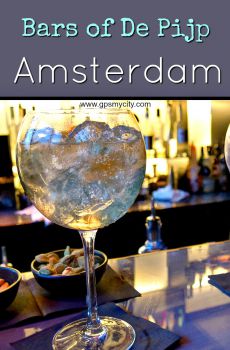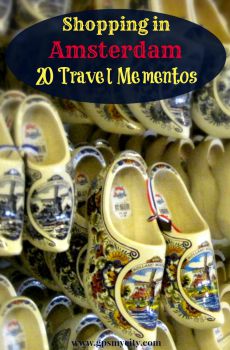Audio Guide: Jewish Quarter Walking Tour (Self Guided), Amsterdam
Welcome to Amsterdam’s Jewish Quarter, a neighborhood rich in history, tracing the ebb and flow of the city’s Jewish community. It all began in the late 16th and early 17th centuries, when Sephardic Jews fleeing persecution in Spain and Portugal found refuge here. With its relatively tolerant atmosphere, Amsterdam quickly became a sanctuary, and before long, Ashkenazi Jews from Central and Eastern Europe joined the growing community.
By the 17th century, the Jewish Quarter had become a vital part of Amsterdam’s cultural and economic landscape. Synagogues, schools, and printing houses flourished, helping to establish the city as a hub of trade, learning, and creativity. Philosophical heavyweights like Baruch Spinoza and artistic legends such as Rembrandt, who lived nearby, were connected to the area.
But it wasn’t all smooth sailing. As the wealthier Jewish residents moved out in the 19th and early 20th centuries, the area became overcrowded and impoverished. Then, during World War II, the quarter endured its darkest chapter: the Nazi occupation devastated the community, leaving much of the neighborhood abandoned and in ruin.
In the postwar years, efforts to restore and honor the Jewish Quarter’s legacy began in earnest. Today, it’s home to several well-known landmarks, such as the Portuguese Synagogue, one of Europe’s best-preserved Sephardic synagogues, and the Jewish Historical Museum, serving as a poignant reminder of the area’s wartime history.
There’s more: Waterlooplein Flea Market, named after the historic Battle of Waterloo; the Rembrandt House Museum, where the master painter once lived and worked; and the Pinto House, a grand residence that once belonged to a prominent Portuguese-Jewish family. Formerly a steam-powered diamond factory, the Gassan Diamonds building offers yet another fascinating glimpse into the neighborhood’s past.
To truly immerse yourself in the history and legacy of the Jewish Quarter, take this self-guided walking tour. It’s your chance to explore the neighborhood’s most iconic sites and uncover the remarkable contributions of Amsterdam’s Jewish community to the city’s story.
By the 17th century, the Jewish Quarter had become a vital part of Amsterdam’s cultural and economic landscape. Synagogues, schools, and printing houses flourished, helping to establish the city as a hub of trade, learning, and creativity. Philosophical heavyweights like Baruch Spinoza and artistic legends such as Rembrandt, who lived nearby, were connected to the area.
But it wasn’t all smooth sailing. As the wealthier Jewish residents moved out in the 19th and early 20th centuries, the area became overcrowded and impoverished. Then, during World War II, the quarter endured its darkest chapter: the Nazi occupation devastated the community, leaving much of the neighborhood abandoned and in ruin.
In the postwar years, efforts to restore and honor the Jewish Quarter’s legacy began in earnest. Today, it’s home to several well-known landmarks, such as the Portuguese Synagogue, one of Europe’s best-preserved Sephardic synagogues, and the Jewish Historical Museum, serving as a poignant reminder of the area’s wartime history.
There’s more: Waterlooplein Flea Market, named after the historic Battle of Waterloo; the Rembrandt House Museum, where the master painter once lived and worked; and the Pinto House, a grand residence that once belonged to a prominent Portuguese-Jewish family. Formerly a steam-powered diamond factory, the Gassan Diamonds building offers yet another fascinating glimpse into the neighborhood’s past.
To truly immerse yourself in the history and legacy of the Jewish Quarter, take this self-guided walking tour. It’s your chance to explore the neighborhood’s most iconic sites and uncover the remarkable contributions of Amsterdam’s Jewish community to the city’s story.
How it works: Download the app "GPSmyCity: Walks in 1K+ Cities" from Apple App Store or Google Play Store to your mobile phone or tablet. The app turns your mobile device into a personal tour guide and its built-in GPS navigation functions guide you from one tour stop to next. The app works offline, so no data plan is needed when traveling abroad.
Jewish Quarter Walking Tour Map
Guide Name: Jewish Quarter Walking Tour
Guide Location: Netherlands » Amsterdam (See other walking tours in Amsterdam)
Guide Type: Self-guided Walking Tour (Sightseeing)
# of Attractions: 11
Tour Duration: 2 Hour(s)
Travel Distance: 2.3 Km or 1.4 Miles
Author: DanaOffice
Sight(s) Featured in This Guide:
Guide Location: Netherlands » Amsterdam (See other walking tours in Amsterdam)
Guide Type: Self-guided Walking Tour (Sightseeing)
# of Attractions: 11
Tour Duration: 2 Hour(s)
Travel Distance: 2.3 Km or 1.4 Miles
Author: DanaOffice
Sight(s) Featured in This Guide:
- Waterloo Square Flea Market
- Museum Het Rembrandthuis (Rembrandt House Museum)
- Huis de Pinto (Pinto House)
- Gassan Diamonds
- Uilenburgersjoel (Uilenburger Synagogue)
- Joods Museum (Jewish Museum)
- De Dokwerker (Dockworker Monument)
- Esnoga (Portuguese Synagogue)
- Hollandsche Schouwburg (Holocaust Memorial & Dutch Theater)
- National Holocaust Museum
- Verzetsmuseum (Dutch Resistance Museum)
1) Waterloo Square Flea Market
Waterloo Square near the Amstel River in Amsterdam was named after the Battle of Waterloo in 1815. Prominent buildings here include the Stopera complex (home to the city hall of Amsterdam and the Dutch National Opera and Ballet) as well as the Moses and Aaron Church.
Waterloo Square was created in 1882 when the local Leper's and Wood canals were filled in. The square became a marketplace when the city government decided that the Jewish merchants from the nearby areas had to move their stalls here. Thus, in 1893, the square became a daily market (operational all week long, except on Saturdays, the Jewish sabbath).
During World War II, the Jewish quarter was emptied of its residents as the Nazis rounded them up and sent them to concentration camps. The Waterloo Square market had disappeared by 1941.
After the war, the deserted Jewish quarter's Waterloo Square market transformed into a bustling flea market. Popular among tourists and locals, it was revived to offer a rustic bazaar atmosphere, providing a space to shop, haggle, and browse a diverse selection of goods.
The market has some 300 stalls and is open every day except Sunday. Given the wide variety of merchandise on offer, it is not meant for rushed browsing. Making quick decisions can be challenging, so be sure to allocate generous time for your visit.
Tip:
If you're inclined towards saving money, take a preliminary tour of the market before making any purchases. Many items, such as hats and sunglasses, can be found at multiple stalls, with prices varying from one vendor to another.
Waterloo Square was created in 1882 when the local Leper's and Wood canals were filled in. The square became a marketplace when the city government decided that the Jewish merchants from the nearby areas had to move their stalls here. Thus, in 1893, the square became a daily market (operational all week long, except on Saturdays, the Jewish sabbath).
During World War II, the Jewish quarter was emptied of its residents as the Nazis rounded them up and sent them to concentration camps. The Waterloo Square market had disappeared by 1941.
After the war, the deserted Jewish quarter's Waterloo Square market transformed into a bustling flea market. Popular among tourists and locals, it was revived to offer a rustic bazaar atmosphere, providing a space to shop, haggle, and browse a diverse selection of goods.
The market has some 300 stalls and is open every day except Sunday. Given the wide variety of merchandise on offer, it is not meant for rushed browsing. Making quick decisions can be challenging, so be sure to allocate generous time for your visit.
Tip:
If you're inclined towards saving money, take a preliminary tour of the market before making any purchases. Many items, such as hats and sunglasses, can be found at multiple stalls, with prices varying from one vendor to another.
2) Museum Het Rembrandthuis (Rembrandt House Museum) (must see)
This old house in Amsterdam's Jews Broadway, with an ornate facade adorned with intricate wooden shutters and an elaborate pediment, was once the home and studio of the Dutch painter Rembrandt van Rijn. Commonly known as Rembrandt, he was a prominent 17th-century figure, rightfully acclaimed as one of the foremost artists of the Dutch Golden Age-a period when the Dutch Empire enjoyed the zenith of its power and renown.
Originally built in 1606, the property served as the artist's residence during the pinnacle of his fame, a place where he resided for nearly two decades, from 1639 to 1658, and created some of his most iconic masterpieces, such as "The Night Watch."
However, the lavish expenditure on furnishings ultimately contributed to Rembrandt's financial downfall. After his bankruptcy, the house changed hands and underwent various renovations before it was purchased by Amsterdam's municipality, in 1907, and then restored and converted into a museum by 1911. The building was redesigned in the 20th century based on the inventory drawn up during Rembrandt's bankruptcy.
The museum shows Rembrandt's living and working quarters, giving the visitor an idea of the artist's daily life. Stepping inside here feels akin to entering one of Rembrandt's own paintings, with quintessential Dutch interiors featuring black-and-white tiled floors and traditional box beds. Two particularly captivating highlights include a nearly complete collection of Rembrandt's etchings, exhibited in its modern wing and etching cabinet. In Rembrandt's old house, there are also works of art by his teacher, Pieter Lastman, and his pupils, Ferdinand Bol and Govert Flinck. The museum also hosts temporary exhibitions throughout the year of the works by Rembrandt's contemporaries and (contemporary) followers.
In 2019, research confirmed that two pots found in Rembrandt’s old cesspool were used by him for mixing quartz soil, a unique canvas preparation method. These pots are now on display here.
Tip:
Reserve some time to browse the museum's quaint shop, offering a selection of delightful, high-quality souvenirs at reasonable prices. It is highly likely that you will want to get something as a keepsake for yourself too.
Originally built in 1606, the property served as the artist's residence during the pinnacle of his fame, a place where he resided for nearly two decades, from 1639 to 1658, and created some of his most iconic masterpieces, such as "The Night Watch."
However, the lavish expenditure on furnishings ultimately contributed to Rembrandt's financial downfall. After his bankruptcy, the house changed hands and underwent various renovations before it was purchased by Amsterdam's municipality, in 1907, and then restored and converted into a museum by 1911. The building was redesigned in the 20th century based on the inventory drawn up during Rembrandt's bankruptcy.
The museum shows Rembrandt's living and working quarters, giving the visitor an idea of the artist's daily life. Stepping inside here feels akin to entering one of Rembrandt's own paintings, with quintessential Dutch interiors featuring black-and-white tiled floors and traditional box beds. Two particularly captivating highlights include a nearly complete collection of Rembrandt's etchings, exhibited in its modern wing and etching cabinet. In Rembrandt's old house, there are also works of art by his teacher, Pieter Lastman, and his pupils, Ferdinand Bol and Govert Flinck. The museum also hosts temporary exhibitions throughout the year of the works by Rembrandt's contemporaries and (contemporary) followers.
In 2019, research confirmed that two pots found in Rembrandt’s old cesspool were used by him for mixing quartz soil, a unique canvas preparation method. These pots are now on display here.
Tip:
Reserve some time to browse the museum's quaint shop, offering a selection of delightful, high-quality souvenirs at reasonable prices. It is highly likely that you will want to get something as a keepsake for yourself too.
3) Huis de Pinto (Pinto House)
Amsterdam’s Saint Anthony’s thoroughfare has seen its share of modern pressures, but the Pinto House stands defiant-a symbol of survival and a hub of local culture. With its elegant off-white Italianate façade, this historic landmark is named after Isaac de Pinto, a Sephardic Jew who fled the Inquisition and ultimately became one of the Dutch East India Company’s founding figures.
In 1651, de Pinto acquired the estate for a hefty 30,000 guilders and transformed it into a lavish showpiece. The house’s stately exterior, crowned by six towering pilasters and an elaborately decorated balustrade, was purposefully designed to impress, drawing the eye upward in admiration.
Inside, the opulence continues. The original painted ceiling, teeming with birds and cherubs, commands attention as the room’s centerpiece. Below, a Louis XIV-style fireplace stands as a testament to the craftsmanship of its era. Together, these elements preserve the Pinto House’s reputation as a beautiful example of both historical significance and timeless elegance.
In 1651, de Pinto acquired the estate for a hefty 30,000 guilders and transformed it into a lavish showpiece. The house’s stately exterior, crowned by six towering pilasters and an elaborately decorated balustrade, was purposefully designed to impress, drawing the eye upward in admiration.
Inside, the opulence continues. The original painted ceiling, teeming with birds and cherubs, commands attention as the room’s centerpiece. Below, a Louis XIV-style fireplace stands as a testament to the craftsmanship of its era. Together, these elements preserve the Pinto House’s reputation as a beautiful example of both historical significance and timeless elegance.
4) Gassan Diamonds
Before the upheaval of World War II, a large portion of Amsterdam’s Jewish community was deeply involved in the delicate art of diamond cutting and polishing. Though the diamond industry isn’t as central to the city’s identity as it once was, one shining exception remains: Gassan Diamonds. This historic factory, housed in a grand brick building from 1879, keeps the tradition alive.
At Gassan, visitors can enjoy a guided tour that offers a peek behind the sparkling curtain. The tour includes stops at the cutting and polishing workshops, followed by a stroll through the jewelry showroom. Here, you can admire an array of dazzling creations or, if you’re feeling indulgent, take home a glittering keepsake.
Your visit kicks off with a friendly guide handing you a sticker. Then, you’ll dive into a 15-minute demonstration of a diamond polisher at work, complete with a crash course on the diamond refinement process. Afterward, you’ll gather for a deeper dive into the nuances of color, clarity, and grading. This part of the tour also features a showcase of diamonds that range from the modestly priced to the jaw-droppingly expensive, with pieces valued from €100 to €50,000.
To cap it all off, there’s an extensive gift shop on-site. Here, you’ll find not just diamonds, but also a treasure trove of classic blue and white Delftware, making it the perfect spot to pick up a memorable souvenir.
At Gassan, visitors can enjoy a guided tour that offers a peek behind the sparkling curtain. The tour includes stops at the cutting and polishing workshops, followed by a stroll through the jewelry showroom. Here, you can admire an array of dazzling creations or, if you’re feeling indulgent, take home a glittering keepsake.
Your visit kicks off with a friendly guide handing you a sticker. Then, you’ll dive into a 15-minute demonstration of a diamond polisher at work, complete with a crash course on the diamond refinement process. Afterward, you’ll gather for a deeper dive into the nuances of color, clarity, and grading. This part of the tour also features a showcase of diamonds that range from the modestly priced to the jaw-droppingly expensive, with pieces valued from €100 to €50,000.
To cap it all off, there’s an extensive gift shop on-site. Here, you’ll find not just diamonds, but also a treasure trove of classic blue and white Delftware, making it the perfect spot to pick up a memorable souvenir.
5) Uilenburgersjoel (Uilenburger Synagogue)
The Uilenburger Synagogue, a refined example of Louis XV Rococo architecture, first opened its doors in 1766. For nearly two centuries, it served the city’s Ashkenazi faithful, and today remains one of the rare surviving landmarks of historic Uilenburg-an artificial island originally developed as part of Amsterdam’s harbor expansion. Tucked into a peaceful inner courtyard, this intimate, inviting space continues to charm visitors with its rich heritage and warm atmosphere.
Back in its earliest days, the synagogue was built close to the water, in the shadow of a windmill serving a local brewery. Hidden away behind rows of houses, reachable only by winding, narrow alleyways, this quiet spot miraculously dodged sweeping redevelopment in the early 20th century that reshaped Amsterdam’s Jewish quarter.
The darkest days came during World War II, when its congregation was tragically diminished by the horrors of the Holocaust, and the synagogue itself suffered severe looting. Yet, it survived. With its elegant bell-shaped gable and striking central projection still intact, the synagogue earned recognition as a national heritage site in 1970 and underwent careful restorations in 1996 and again in 2015.
Since 2002, the Uilenburger Synagogue Foundation has been reconnecting the synagogue to its Jewish roots, bringing fresh energy and purpose to the space. Now it’s more lively than ever-a thriving cultural hub welcoming Jewish organizations and wider audiences alike for concerts, exhibitions, spiritual services, and more. A beautiful space where the past and present meet.
Back in its earliest days, the synagogue was built close to the water, in the shadow of a windmill serving a local brewery. Hidden away behind rows of houses, reachable only by winding, narrow alleyways, this quiet spot miraculously dodged sweeping redevelopment in the early 20th century that reshaped Amsterdam’s Jewish quarter.
The darkest days came during World War II, when its congregation was tragically diminished by the horrors of the Holocaust, and the synagogue itself suffered severe looting. Yet, it survived. With its elegant bell-shaped gable and striking central projection still intact, the synagogue earned recognition as a national heritage site in 1970 and underwent careful restorations in 1996 and again in 2015.
Since 2002, the Uilenburger Synagogue Foundation has been reconnecting the synagogue to its Jewish roots, bringing fresh energy and purpose to the space. Now it’s more lively than ever-a thriving cultural hub welcoming Jewish organizations and wider audiences alike for concerts, exhibitions, spiritual services, and more. A beautiful space where the past and present meet.
6) Joods Museum (Jewish Museum)
Cleverly shoehorned within a remarkable complex of four Ashkenazic synagogues from the 17th and 18th centuries, this museum is the crown jewel of Amsterdam’s Jewish Cultural Quarter. What sets it apart is its focus. Instead of dwelling solely on the Holocaust, it dives deep into every facet of Jewish life and the community’s evolving relationship with the city of Amsterdam. In fact, it’s a rarity not just in the Netherlands but perhaps the entire world. Its collection of documents, artifacts, and manuscripts is nothing short of extraordinary, all displayed in a thoughtful, context-rich environment.
For centuries, Amsterdam-known as “Mokum” in Hebrew-was a haven for Jewish refugees, welcoming both Sephardic Jews fleeing Iberia and Ashkenazi Jews arriving from Central and Eastern Europe. Despite sharing a common faith, these two groups led distinctly different lives, adding layers of complexity to Dutch society.
One of the museum’s most fascinating features is its attention to detail. Exhibits clearly explain the contrasts between different Jewish diasporas and how their coexistence shaped the Netherlands. Visitors can explore a reconstructed synagogue that illuminates the beauty of Jewish worship, as well as displays highlighting Jewish contributions to various trades and professions. These insights are skillfully contrasted with the struggles of impoverished Jewish communities, creating a nuanced and complete picture of Jewish life in Amsterdam. And when you need a break, there’s a kosher café and a bookshop packed with fantastic finds.
Best of all, a single ticket grants access to other nearby treasures: the stunning Portuguese Synagogue, the Holocaust Museum, and the engaging Children’s Museum.
Tip:
Planning to visit on a weekend? Don’t miss the bustling market just outside the museum-it’s the perfect way to round out your day.
For centuries, Amsterdam-known as “Mokum” in Hebrew-was a haven for Jewish refugees, welcoming both Sephardic Jews fleeing Iberia and Ashkenazi Jews arriving from Central and Eastern Europe. Despite sharing a common faith, these two groups led distinctly different lives, adding layers of complexity to Dutch society.
One of the museum’s most fascinating features is its attention to detail. Exhibits clearly explain the contrasts between different Jewish diasporas and how their coexistence shaped the Netherlands. Visitors can explore a reconstructed synagogue that illuminates the beauty of Jewish worship, as well as displays highlighting Jewish contributions to various trades and professions. These insights are skillfully contrasted with the struggles of impoverished Jewish communities, creating a nuanced and complete picture of Jewish life in Amsterdam. And when you need a break, there’s a kosher café and a bookshop packed with fantastic finds.
Best of all, a single ticket grants access to other nearby treasures: the stunning Portuguese Synagogue, the Holocaust Museum, and the engaging Children’s Museum.
Tip:
Planning to visit on a weekend? Don’t miss the bustling market just outside the museum-it’s the perfect way to round out your day.
7) De Dokwerker (Dockworker Monument)
Standing resolutely in a small square outside the Portuguese Synagogue, the Dockworker statue, sculpted by Mari Andriessen, honors the working class of Amsterdam, not limited to dockworkers alone. It commemorates the February 1941 strike, when the city’s laborers-dockworkers, tram drivers, and others-rose in protest against the Nazis’ brutal treatment of the Jewish community.
This historic strike was triggered by a violent Nazi crackdown in Amsterdam’s old Jewish quarter. The Germans had launched retaliatory arrests and pogroms following a street skirmish that left several Dutch police officers injured. The city’s workers, led by the outlawed Communist Party, organized the first public protest against Nazi oppression in all of occupied Europe.
On February 26, 1941, over 300,000 citizens took to the streets. The strike lasted two days before being crushed by the German authorities. Still, its legacy endures. Each year, on February 25, people gather at the Dockworker statue for a memorial ceremony. Wreaths are laid, and a procession passes by to honor the courage of those who dared to defy tyranny. Politicians, public transportation officials, and Holocaust survivor groups come together, ensuring that this powerful story of resistance is never forgotten.
This historic strike was triggered by a violent Nazi crackdown in Amsterdam’s old Jewish quarter. The Germans had launched retaliatory arrests and pogroms following a street skirmish that left several Dutch police officers injured. The city’s workers, led by the outlawed Communist Party, organized the first public protest against Nazi oppression in all of occupied Europe.
On February 26, 1941, over 300,000 citizens took to the streets. The strike lasted two days before being crushed by the German authorities. Still, its legacy endures. Each year, on February 25, people gather at the Dockworker statue for a memorial ceremony. Wreaths are laid, and a procession passes by to honor the courage of those who dared to defy tyranny. Politicians, public transportation officials, and Holocaust survivor groups come together, ensuring that this powerful story of resistance is never forgotten.
8) Esnoga (Portuguese Synagogue)
Amsterdam’s reputation for tolerance and religious freedom made it a beacon for Jews fleeing persecution. By the late 15th century, Jews escaping Spain and Portugal’s Inquisition found refuge in the Netherlands. At the time, the Dutch Republic was at odds with Spain, so these newcomers adopted the label “Portuguese Jews” to keep things simple and avoid further conflict.
The community flourished, and by 1665, their crowning achievement took shape: the grand Portuguese Synagogue-also known as the Esnoga. Its design borrowed from the Neoclassical style popular in the Netherlands, with elegant pilasters and a concealed balustrade. At the time, it was the largest synagogue in the world, inspired by the grandeur of Solomon’s Temple in Jerusalem.
To this day, the Esnoga remains a portal to the past. Standing along one of Amsterdam’s busiest streets, its 17th-century design and interiors remarkably untouched. Electric lights? You won’t find them here. Instead, you’ll be welcomed by the flicker of roughly 1,000 candles, their soft glow illuminating antique furnishings and intricate décor.
Tourists are invited to explore Europe’s second-oldest synagogue still in continuous use, and as a bonus, each admission includes access to the Jewish Historical Museum, conveniently located just steps away across the street.
Insider Tip:
Don’t just admire the main hall-explore the annexes. The board room, winter synagogue, candle room, and mourning room each tell their own story. Be sure to head down to the treasure chambers, where you’ll find precious 16th-century manuscripts, gold-threaded tapestries, and books from the oldest Jewish library in the world.
The community flourished, and by 1665, their crowning achievement took shape: the grand Portuguese Synagogue-also known as the Esnoga. Its design borrowed from the Neoclassical style popular in the Netherlands, with elegant pilasters and a concealed balustrade. At the time, it was the largest synagogue in the world, inspired by the grandeur of Solomon’s Temple in Jerusalem.
To this day, the Esnoga remains a portal to the past. Standing along one of Amsterdam’s busiest streets, its 17th-century design and interiors remarkably untouched. Electric lights? You won’t find them here. Instead, you’ll be welcomed by the flicker of roughly 1,000 candles, their soft glow illuminating antique furnishings and intricate décor.
Tourists are invited to explore Europe’s second-oldest synagogue still in continuous use, and as a bonus, each admission includes access to the Jewish Historical Museum, conveniently located just steps away across the street.
Insider Tip:
Don’t just admire the main hall-explore the annexes. The board room, winter synagogue, candle room, and mourning room each tell their own story. Be sure to head down to the treasure chambers, where you’ll find precious 16th-century manuscripts, gold-threaded tapestries, and books from the oldest Jewish library in the world.
9) Hollandsche Schouwburg (Holocaust Memorial & Dutch Theater)
The Dutch Theater started as a lively venue where Jewish artists could shine and share their talents without fear. But in October 1941, the Nazis took over, turning it into a grim holding center. It became a gathering place for Amsterdam’s Jewish community before their devastating deportations the following summer. Inside, the darkened space and dire conditions foreshadowed the horrors that awaited them.
After the war, the building’s future hung in uncertainty. Eventually, its facade was restored and the front area refurbished. Today, visitors can see an eternal flame on the ground floor, positioned before a poignant list of those lost in the concentration camp. Four short films guide you through the theater’s journey and its dark history. Upstairs, a small exhibit remembers the pre-war days of the Dutch Theater, while the next level houses a detailed display on the city’s Jewish community during the Holocaust, filled with wartime photos and haunting film clips.
The old auditorium at the rear, however, remains a stark contrast. Open to the sky, with its roof long gone, it’s an empty shell of what it once was. Where the stage once stood, a basalt memorial column rises from a Star of David base. The space is a solemn, heartrending tribute-a permanent reminder of the countless lives forever altered.
After the war, the building’s future hung in uncertainty. Eventually, its facade was restored and the front area refurbished. Today, visitors can see an eternal flame on the ground floor, positioned before a poignant list of those lost in the concentration camp. Four short films guide you through the theater’s journey and its dark history. Upstairs, a small exhibit remembers the pre-war days of the Dutch Theater, while the next level houses a detailed display on the city’s Jewish community during the Holocaust, filled with wartime photos and haunting film clips.
The old auditorium at the rear, however, remains a stark contrast. Open to the sky, with its roof long gone, it’s an empty shell of what it once was. Where the stage once stood, a basalt memorial column rises from a Star of David base. The space is a solemn, heartrending tribute-a permanent reminder of the countless lives forever altered.
10) National Holocaust Museum
Housed in a former school next to a nursery, this museum tells a deeply moving story you won’t soon forget. Its focus is on the experiences of Jewish children-up to 12 years old-who, separated from their parents, waited in uncertainty before being deported.
In October 1942, after the Nazis commandeered the nursery, members of the Jewish Council working at the deportation site teamed up with resistance members and the nursery’s director in a bold rescue effort. They managed to hide Jewish children within the school, creating what eventually became a smuggling network for those otherwise destined for the camps.
Visiting the Holocaust Museum is both enlightening and heart-wrenching. You’ll see children’s belongings, personal stories, and photographs that have emerged from private collections and antique shops after the war. Together, these artifacts offer a glimpse into lives abruptly and tragically cut short-just a fraction of the over 104,000 Dutch Jewish lives lost during the Holocaust.
Traveler’s Tip:
Right across the street is the National Holocaust Names Memorial. It’s worth a visit to see the names of every known Dutch Jewish victim etched into its walls-a powerful and solemn reminder of the immense loss.
In October 1942, after the Nazis commandeered the nursery, members of the Jewish Council working at the deportation site teamed up with resistance members and the nursery’s director in a bold rescue effort. They managed to hide Jewish children within the school, creating what eventually became a smuggling network for those otherwise destined for the camps.
Visiting the Holocaust Museum is both enlightening and heart-wrenching. You’ll see children’s belongings, personal stories, and photographs that have emerged from private collections and antique shops after the war. Together, these artifacts offer a glimpse into lives abruptly and tragically cut short-just a fraction of the over 104,000 Dutch Jewish lives lost during the Holocaust.
Traveler’s Tip:
Right across the street is the National Holocaust Names Memorial. It’s worth a visit to see the names of every known Dutch Jewish victim etched into its walls-a powerful and solemn reminder of the immense loss.
11) Verzetsmuseum (Dutch Resistance Museum)
Just a stone's throw away from the Amsterdam Royal Zoo, the Dutch Resistance Museum transports its visitors to a pivotal juncture in Dutch history - the era of the Dutch Resistance. This establishment serves as a living chronicle, documenting the ascent of Hitler in Germany, the subsequent invasion of the Netherlands, and the valiant struggle of the Dutch people.
It delves deep into the societal transformations and prevailing beliefs during and after the tumultuous period of the Second World War. Undoubtedly, the museum sets the stage against the backdrop of the harrowing history of the Jewish community, elucidating the gradual isolation imposed upon them by the Germans, severing their ties with the wider Dutch populace before the ultimate tragedy unfolded.
Although comparatively modest in size, confined to a single floor when measured against other museums, the Dutch Resistance Museum effectively arranges its thematic exhibits in a contemporary manner, meticulously adhering to chronological order. It distinguishes itself by prioritizing personal narratives, conveyed through video and audio presentations, rather than static displays.
While most exhibits are furnished with English translations, the complimentary audio guide offers an opportunity for more in-depth exploration and proves to be a valuable resource (it also proves to be more user-friendly than the conventional push-button guides found in many galleries and museums).
For those seeking a departure from the conventional art-focused museum scene, a visit to the Dutch Resistance Museum comes highly recommended, particularly for history enthusiasts and individuals intrigued by the multifaceted facets of the Second World War-be it political, ideological, social, or personal.
Tip:
There are two distinct routes available, catering to both adults and children. The latter is very well done, featuring one of the finest museum installations; however, it's important to note that children must be accompanied.
It delves deep into the societal transformations and prevailing beliefs during and after the tumultuous period of the Second World War. Undoubtedly, the museum sets the stage against the backdrop of the harrowing history of the Jewish community, elucidating the gradual isolation imposed upon them by the Germans, severing their ties with the wider Dutch populace before the ultimate tragedy unfolded.
Although comparatively modest in size, confined to a single floor when measured against other museums, the Dutch Resistance Museum effectively arranges its thematic exhibits in a contemporary manner, meticulously adhering to chronological order. It distinguishes itself by prioritizing personal narratives, conveyed through video and audio presentations, rather than static displays.
While most exhibits are furnished with English translations, the complimentary audio guide offers an opportunity for more in-depth exploration and proves to be a valuable resource (it also proves to be more user-friendly than the conventional push-button guides found in many galleries and museums).
For those seeking a departure from the conventional art-focused museum scene, a visit to the Dutch Resistance Museum comes highly recommended, particularly for history enthusiasts and individuals intrigued by the multifaceted facets of the Second World War-be it political, ideological, social, or personal.
Tip:
There are two distinct routes available, catering to both adults and children. The latter is very well done, featuring one of the finest museum installations; however, it's important to note that children must be accompanied.
Walking Tours in Amsterdam, Netherlands
Create Your Own Walk in Amsterdam
Creating your own self-guided walk in Amsterdam is easy and fun. Choose the city attractions that you want to see and a walk route map will be created just for you. You can even set your hotel as the start point of the walk.
Museum Quarter Walking Tour
The Museum Quarter (Museumkwartier) of Amsterdam gets its name from the major museums located in Museum Square therein, namely: the Rijksmuseum, the Stedelijk Museum and the Van Gogh Museum. In fact, it is the construction of the former that boosted the development of the whole neighborhood. Other than museums, the area is also home to the world-famous IAmsterdam letters, as well as exclusive... view more
Tour Duration: 1 Hour(s)
Travel Distance: 0.7 Km or 0.4 Miles
Tour Duration: 1 Hour(s)
Travel Distance: 0.7 Km or 0.4 Miles
Red Light District Walking Tour
For centuries, Amsterdam’s Red Light District has been a source of endless intrigue. Its heart and the most historic section, De Wallen, is a fascinating blend of medieval charm and modern-day notoriety. Here, you’ll find timeworn canal houses leaning at curious angles, narrow cobblestone alleys lined with old bars, cozy shops, and a sprinkling of late-night establishments. And of course, the... view more
Tour Duration: 1 Hour(s)
Travel Distance: 1.8 Km or 1.1 Miles
Tour Duration: 1 Hour(s)
Travel Distance: 1.8 Km or 1.1 Miles
Southern Canal Belt Walking Tour
The Canal District, known as Grachtengordel in Dutch, is a globally renowned example of urban planning and architectural excellence within Amsterdam. This area has remained remarkably well-preserved for over four centuries, celebrated for its charming small bridges, canal crossings, and 17th-century residences. Encircling the Old City Centre in a horseshoe shape, the Canal Ring encompasses three... view more
Tour Duration: 2 Hour(s)
Travel Distance: 3.1 Km or 1.9 Miles
Tour Duration: 2 Hour(s)
Travel Distance: 3.1 Km or 1.9 Miles
Western Canal Belt Walking Tour
The Western Canal Belt is Amsterdam at its most iconic-picture-perfect and brimming with history. Part of the city’s famed Canal Ring, a UNESCO World Heritage Site, it’s a neighborhood that marries beauty and function.
Back in the 17th century, the three major canals-the Gentlemen’s Canal, the Emperor’s Canal, and the Prince’s Canal-were masterfully designed to loop around the... view more
Tour Duration: 2 Hour(s)
Travel Distance: 2.6 Km or 1.6 Miles
Back in the 17th century, the three major canals-the Gentlemen’s Canal, the Emperor’s Canal, and the Prince’s Canal-were masterfully designed to loop around the... view more
Tour Duration: 2 Hour(s)
Travel Distance: 2.6 Km or 1.6 Miles
Amsterdam Introduction Walking Tour
The Dutch capital, Amsterdam, some say, “dances to its own beat.” Indeed, Amsterdam – where “hipness meets history” – has a rather unusual life rhythm and style, famously manifested in the air of legalized cannabis, coffee shops, and the Red Light District. In large part, this “air of freedom” attracts annually to the city over five million visitors.
As a small fishing village,... view more
Tour Duration: 2 Hour(s)
Travel Distance: 4.0 Km or 2.5 Miles
As a small fishing village,... view more
Tour Duration: 2 Hour(s)
Travel Distance: 4.0 Km or 2.5 Miles
Amsterdam's Historical Churches Walking Tour
The history of Amsterdam is deeply intertwined with its religious heritage. The city is home to several historical churches, each with its own unique charm and significance. These religious sites serve as both spiritual centers and architectural treasures that provide insight into the city's past.
Our walk starts in the Central Station area and leads you to visit the eight most prominent... view more
Tour Duration: 2 Hour(s)
Travel Distance: 3.8 Km or 2.4 Miles
Our walk starts in the Central Station area and leads you to visit the eight most prominent... view more
Tour Duration: 2 Hour(s)
Travel Distance: 3.8 Km or 2.4 Miles
Useful Travel Guides for Planning Your Trip
The Oldest and Historic Pubs of Amsterdam
Amsterdam is a stunningly beautiful city, steeped in history, with hidden treasures and fascinating tales practically around every corner. Like all marvelous cities, Amsterdam has its share of dining and drinking establishments from the modern to the ancient. This guide will assist you in exploring...
Dutch Sweets and Pastries
Known primarily for their cheeses, the Dutch have proven just as passionate about their sweets and pastries, many of which have come about as a result of the centuries of colonial past that had infused Holland with Oriental flavors and ingredients. Blended with their own dairy-rich European...
Top 7 Dutch Cheeses to Try in Amsterdam
Don't mind things turning a bit "cheesy" when in Holland. After all, this small country is renowned for its cheese manufacturing and successfully competes, in terms of cheese exports, with such economic giants as the United States and Germany. Amsterdam alone and its vicinities are...
12 Traditional Dutch Foods You Must Try in Amsterdam
Cool climate, closeness to sea, and sense of adventure have made the Dutch what they are – skillful farmers, industrious seafarers and, generally, people with the taste for life and good hearty meal, whether it comes from the sea they live by or the land they set their feet on. All of this has...
Bars of De Pijp, Amsterdam
Sitting to the south of the Centrum (city centre) De Pijp area of Amsterdam is a fascinating mixture of trendy urbanites, students, immigrants and Amsterdammers. De Pijp has a long history as the Bohemian part of town, which is reflected in the different cafés of the area. There truly is something...
Souvenir Shopping in Amsterdam: 20 Dutch Things To Buy
Tulips, red lights, weed... Other than these, there are plenty of good things to remember Amsterdam by. What's more, you can take home some of them quite legally. Look here to see what to buy in Amsterdam and...
The Most Popular Cities
/ view all
